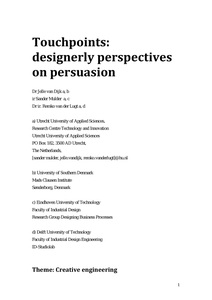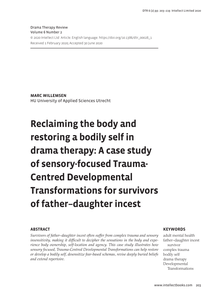Created for the 2019 Prague Quadrennial’s 36Q°, Blue Hour VR was a site-responsive mixed reality performative installation that placed the spectator, as experiencer, within a hybrid landscape of real- time three-dimensional computer graphics and 360-degree video. This article describes the design process, staging and experience of Blue Hour VR from the vantage point of its creators. Using a phenomenological perspective, the article discusses how Blue Hour VR staged presence and embodiment within an intermedial haptic experience. Blue Hour VR demonstrates how virtual reality technology can be harnessed by a mixed reality performance design, which includes both the material and virtual environment, creating a complex stratigraphy of intermedial textures and visual dramaturgies that co-exist inside, outside and in between perceptual realities. In doing so, the article aims to contribute to the limited body of work on mixed and virtual reality in the context of theatre and performance design.
DOCUMENT

This paper explores the intersection of Human-Comput- er Integration (HInt) and Critical Disability Studies (CDS) to explore how a posthumanistic epistemology in design can produce knowledge and know-how for the application do- mains of Health and Well-being. To use disability as a catalyst for innovation, a rethinking in the philosophy of sciences is necessary to establish knowledge production that emerges from new fluid politics that operate in ‘composition’ instead of ‘organization’. By placing an emphasis on nomadic practic- es that move beyond fixed borders, the encounters between Disability Studies or Human-Computer Integration can pro- duce situated, embodied and contingent design knowledge that study deviant and complex embodiment, and the kinds of alterations of human characteristics and abilities through technology. The first section of this paper explores the re- thinking in the philosophy of sciences. The second section ar- gues for a posthumanistic epistemology in design, which can be seen as the perfect way to produce situated, embodied and contingent design knowledge on the intersection of HInt and CDS. The final section of this paper highlights the poten- tial for the disciplines of Somatechnics and Soma Design to engage in each other’s body of knowledge to produce trans- formative knowledge through a shared focus on deviant em- bodiment and disability. The takeaway message of this paper is that the intersection of HInt and CDS potentially leads to new – otherwise overlooked - insights on the human-technol- ogy relationship, and therefore can take part in the historical strive for man-machine symbiosis. The posthumanist episte- mology allows for alternative ways of thinking that move be- yond the current Humanist perspective, and builds on a plu- ral, relational and expansive foundation for the development of design practices that catalyze innovation in the application domains of Health and Well-being.
DOCUMENT

from the article: "We present a case study as part of an investigation into the value of Embodied theory for the design of mixed physical digital interactive products. An interactive light system was designed that empowers an independent living person with an Autistic Spectrum Disorder (ASD) in managing domestic activities. Reflecting on the case we develop our vision of Embodied Functionality (EF). Designing for EF goes beyond ‘distributing’ information technology in the environment. It aims at creating interactive physical digital products that play a functional role (i.e. become part of) a person’s embodied being‐in‐the- world, involving a person’s identity. It does so by utilizing existing structure and by supporting action ‐perception couplings, reflection in- and on action and autonomy in social coordination. EF opens up an alternative design space holding the promise of a more successful appropriation of interactive (assistive) products into people’s everyday lives. "
DOCUMENT

Our approach builds on both the design traditions of participatory design and embodiment. We attempt to connect these traditions to the existing body of knowledge on persuasion. First we describe some basic theoretical concepts and infer how they influence persuasive design. Then we present a basic framework with which we intend to address the different abstraction layers involved. Finally, we discuss the principal differences and meeting areas between the disciplines of design and communication, ending up with some considerations for a persuasion toolbox that is intended to help communication professionals and designers effectively design behavior change interventions that fit the messy lives of people in the real world
DOCUMENT

To reach for abstraction is a major but challenging goal in mathematics education: teachers struggle with finding ways how to foster abstraction in their classes. To shed light on this issue for the case of geometry education, we align theoretical perspectives on embodied learning and abstraction with practical perspectives from in-service teachers. We focus on the teaching and learning of realistic geometry, not only because this domain is apt for sensori-motor action investigations, but also because abstraction in realistic geometry is under-researched in relation to other domains of mathematics, and teachers’ knowledge of geometry and confidence in teaching it lag behind. The following research question will be addressed: how can a theoretical embodied perspective on abstraction in geometry education in the higher grades of primary school inform current teacher practices? To answer this question, we carried out a literature study and an interview study with in-service teachers (n = 6). As a result of the literature study, we consider embodied abstraction in geometry as a process of reflecting on, describing, explaining, and structuring of sensory-motor actions in the experienced world through developing and using mathematical artifacts. The results from the interview study show that teachers are potentially prepared for using aspects of embodied learning (e.g., manipulatives), but are not aware of the different aspects of enactment that may invite students’ abstraction. We conclude that theories on embodiment and abstraction do not suffice to foster students’ abstraction process in geometry. Instead, teachers’ knowledge of embodied abstraction in geometry and how to foster this grows with experience in enactment, and with the discovery that cognition emerges to serve action.
LINK
This investigation explores relations between 1) a theory of human cognition, called Embodied Cognition, 2) the design of interactive systems and 3) the practice of ‘creative group meetings’ (of which the so-called ‘brainstorm’ is perhaps the best-known example). The investigation is one of Research-through-Design (Overbeeke et al., 2006). This means that, together with students and external stakeholders, I designed two interactive prototypes. Both systems contain a ‘mix’ of both physical and digital forms. Both are designed to be tools in creative meeting sessions, or brainstorms. The tools are meant to form a natural, element in the physical meeting space. The function of these devices is to support the formation of shared insight: that is, the tools should support the process by which participants together, during the activity, get a better grip on the design challenge that they are faced with. Over a series of iterations I reflected on the design process and outcome, and investigated how users interacted with the prototypes.
DOCUMENT

Empirical studies in the creative arts therapies (CATs; i.e., art therapy, dance/movement therapy, drama therapy, music therapy, psychodrama, and poetry/bibliotherapy) have grown rapidly in the last 10 years, documenting their positive impact on a wide range of psychological and physiological outcomes (e.g., stress, trauma, depression, anxiety, and pain). However, it remains unclear how and why the CATs have positive effects, and which therapeutic factors account for these changes. Research that specifically focuses on the therapeutic factors and/or mechanisms of change in CATs is only beginning to emerge. To gain more insight into how and why the CATs influence outcomes, we conducted a scoping review (Nstudies = 67) to pinpoint therapeutic factors specific to each CATs discipline, joint factors of CATs, and more generic common factors across all psychotherapy approaches. This review therefore provides an overview of empirical CATs studies dealing with therapeutic factors and/or mechanisms of change, and a detailed analysis of these therapeutic factors which are grouped into domains. A framework of 19 domains of CATs therapeutic factors is proposed, of which the three domains are composed solely of factors unique to the CATs: “embodiment,” “concretization,” and “symbolism and metaphors.” The terminology used in change process research is clarified, and the implications for future research, clinical practice, and CATs education are discussed.
DOCUMENT

Methodological challenges are rarely discussed in depth among outdoor adventure tourism scholars. Despite the prevailing qualitative approaches in this field, and the recognition that the fleetingness of the human experience and the non-linearity and unpredictability of the more-than-human world have the power to influence the research process, the messy, negotiated and often contested researcher’s role has been less considered. In addressing this, the aim here is to critically discuss the methodological approach to explorations of the outdoor experiences through deconstructing the researcher’s role. Through renderings of the existentialist propositions of being in the world and a poststructuralist philosophy of fluidity and flux, the attention is granted to embodied experiences as a way of generating knowledges. Being situated in the research setting, space is created for interrogation of the processual dimensions of commodified outdoor journeys from an emic, researcher-as-tourist perspective. Research in the outdoor scenaria is by no means a linear process but rather a messy, complex and often ruptured journey, further complicated by the ethical concerns, struggles and idiosyncrasies of the researcher. I thus discuss the nuances and complexities of doing the embodied research and the haphazard ways of data collection. In shifting attention to more existential aspects of being in the outdoors through the process of post-experiential reflections, discomfort emerged as a critical quality of the outdoor experience. I thus illuminate the significance of embodied research and epiphenomenal discoveries in the production of new knowledges, to which greater attention, both in theoretical and methodological conversations, should be paid in the future.
LINK
Survivors of father–daughter incest often suffer from complex trauma and sensory insensitivity, making it difficult to decipher the sensations in the body and experience body ownership, self-location and agency. This case study illustrates how sensory focused, Trauma-Centred Developmental Transformations can help restore or develop a bodily self, desensitize fear-based schemas, revise deeply buried beliefs and extend repertoire.
DOCUMENT

This book offers a comprehensive, practice-based exploration of Systemic Co-Design (SCD) as it is applied to society’s most complex and urgent transitions. Drawing on collaborative projects from the Expertisenetwork Systemic Co-Design (ESC), it portrays Systemic Co-Design not as a fixed framework but as a reflexive, evolving practice. The chapters present diverse collaborations and inquiries, ranging from inclusive design and digital accessibility to fostering safety cultures and urban co-creation, that illustrate Systemic Co-Design’s capacity to build awareness, trust, and communities, as well as systemic capabilities. The book promotes mutual learning and generates knowledge products such as maps, canvases, cards, games, and embodied interactions that enable meaningful engagement. Key themes that run throughout include continuous reflection, the blending of action research and design experimentation, and collective sense-making across disciplines. The contributions demonstrate how new values, methods, and communities are co-developed with design practitioners, policymakers, educators, and citizens. Together, they demonstrate how Systemic Co-Design achieves practical outcomes while fostering the longterm capacities and cultural shifts necessary for systemic change.
LINK